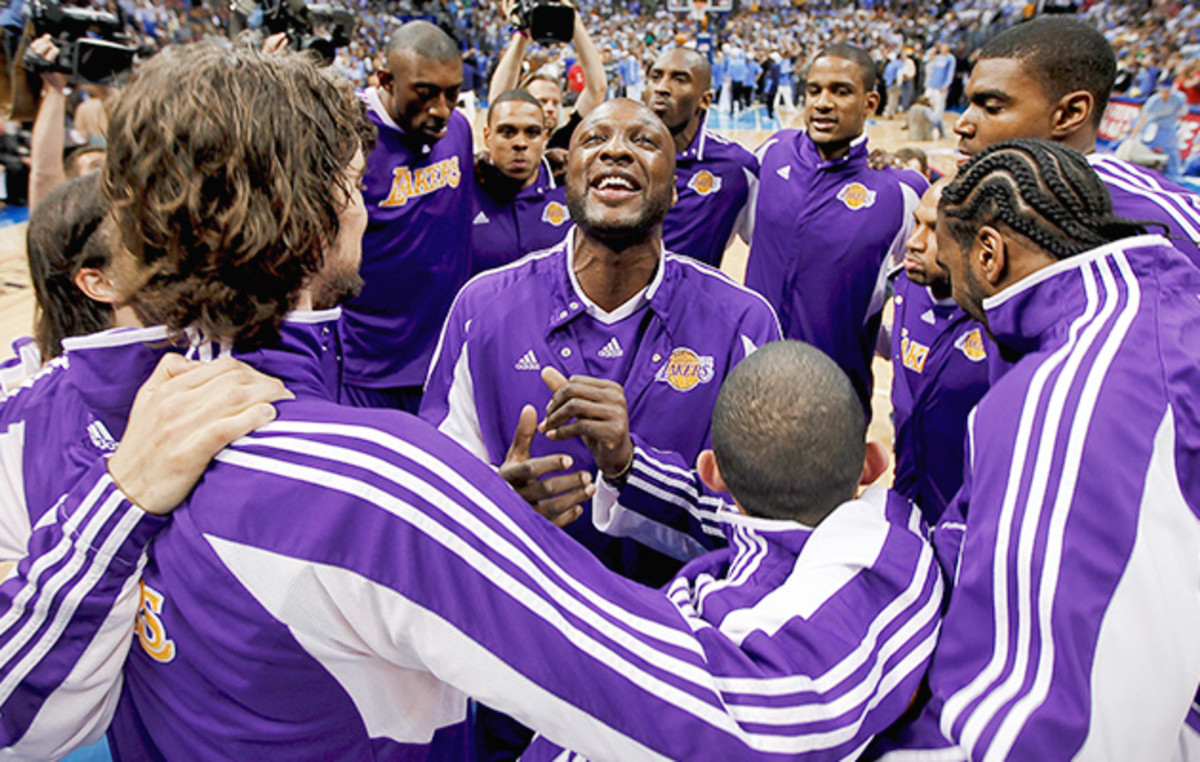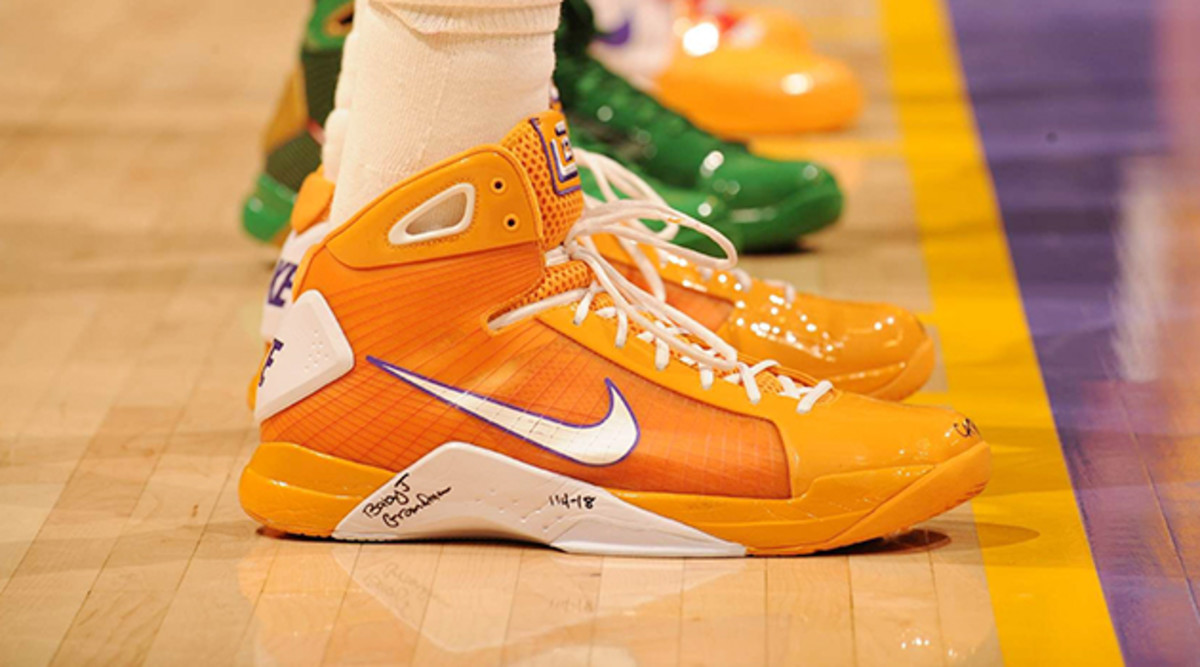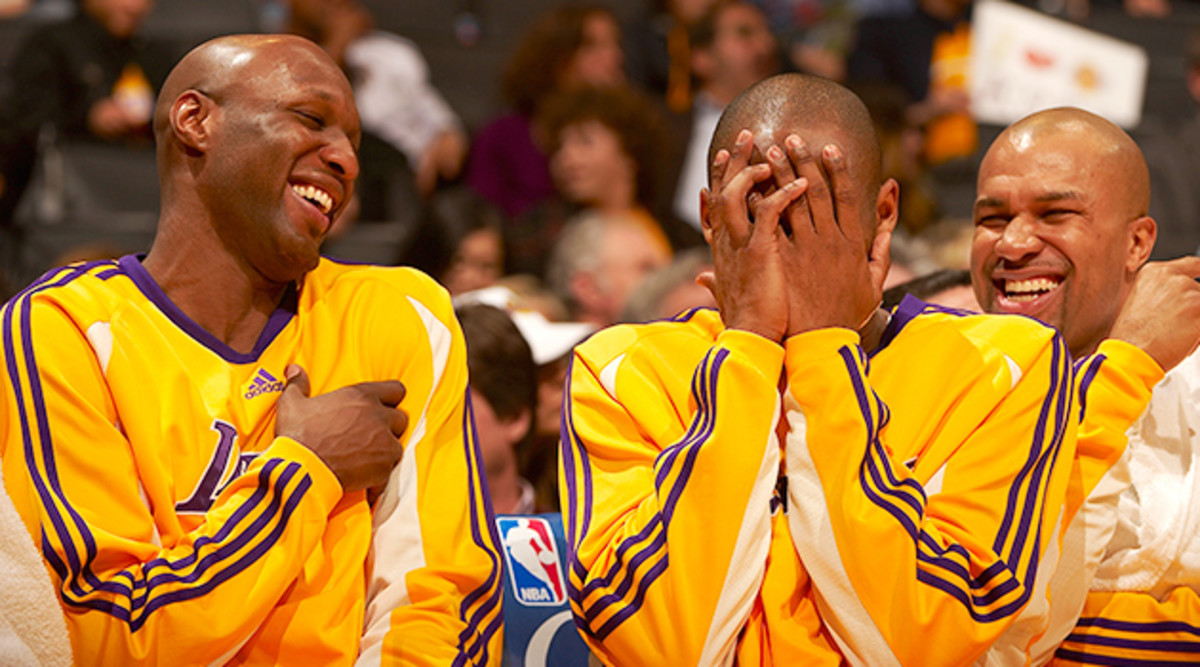SI Vault: The odyssey of Lamar Odom

Editor's note: This story was originally published in the March 23, 2009 issue of SPORTS ILLUSTRATED. Lamar Odom was reportedly found unconscious on Tuesday at a Nevada brothel. He's currently being treated at a nearby hospital.
The happiest Laker is the one whose father was addicted to heroin, whose mother died of colon cancer when he was 12, who attended three high schools, had his first college scholarship revoked before the fall semester of his freshman year, became a subject of three college investigations, declared for the NBA draft, tried unsuccessfully to pull out of the draft, was picked by arguably the worst franchise in sports, violated the league’s antidrug policy twice within eight months and after finally getting his life together, went home to New York City for an aunt’s funeral and wound up burying his 6 1/2-month-old son, then getting robbed at gunpoint.
“That's my book,” says Lamar Odom. “That’s my movie. It’s a big bowl of gumbo.”
As he ponders working titles for his life story—“This is L.A., so you never know,” he says—he is wearing a white sweat suit and driving a white Mercedes down Interstate 405 to an autograph signing in Orange County, one hand on the steering wheel and another deep inside a bag of potato chips. Every few minutes, he turns and glances at the backseat, where his 10-year-old daughter, Destiny, and 7-year-old son, Lamar Jr., are occupied with their own snacks.
“My grandmother was always upbeat, a naturally happy person,” he says, chomping on the chips. “I think I got that from her.” His grandmother was Mildred Mercer, who raised him when his parents were gone. She died on June 28, 2003, three years to the day before his baby boy.
Lamar Odom in hospital after being found unconscious in Nevada brothel
Maybe Grandma Mildred is to thank for one of the most irrepressible personalities in the NBA, a 6'10" forward who, at 29, has been in the league for 10 seasons and famous for nearly half his life, and yet still wears his mitt when he goes to baseball games in the hope of catching a foul ball, collects pro wrestling figurines as a hobby and asks the staffer behind him on the team’s plane for permission to recline his seat because “my legs are kind of long.” More than an hour into the autograph signing in Huntington Beach, Destiny spotted a bulge in her dad’s left sneaker. “What's that?” she asked. Odom reached into his size-16 hightop and pulled out the crumpled potato chip bag. “I didn’t know what else to do with it,” he said. Destiny smiled and shook her head.
If you were going to build a basketball player in a lab, it might look like Lamar Odom, a broad-shouldered Stretch Armstrong. He’s a point guard in a power forward’s body, long enough to anchor the post but coordinated enough to lead the break. The problem with trying to engineer another Odom is programming what he’s going to say. After his best game of this season, when he scored 28 points and grabbed 17 rebounds in Cleveland in February, capping a 6–0 road trip and dealing the Cavaliers their first home loss of the season, he said in a postgame interview, “I'm ready to go home and put my feet in the sand.” A month later, as he walked barefoot down Manhattan Beach, sweatpants hiked up to his knees, view clear to Catalina Island, he cooed, “This is the Laker lifestyle.” He is an unrestricted free agent after the season and cannot fathom a move inland.
While Kobe Bryant is the king of Staples Center, Odom is a gifted and versatile court jester. “I’ve heard fans yell to him in the middle of games, ‘Nice shot!’ and he’ll turn around and say, ‘Thanks, man,’” says John Ireland, sideline reporter for Lakers telecasts on KCAL 9. Before the Dec. 25 game against the Celtics at Staples, Odom was wishing fans in the courtside seats Merry Christmas when he stopped at Adam Sandler. “Happy Hanukkah,” he said. Topics in his interviews range from his favorite TV show (MacGyver) to his favorite tourist destination (“Paris,” he says. “I can smell the wine in the air”) to his alter ego (“There's Lamar, who’s humble, and then there’s Odom”) to his unconventional wardrobe, including a Sergeant Pepper–style ensemble that prompted coach Phil Jackson to ask Odom if he had come to the arena straight from band practice. Says point guard Derek Fisher, “He's our new Shaquille O’Neal.”
Odom carries himself with an ease and optimism reminiscent of O’Neal and before that Magic Johnson, but he is an original. The person he calls Dad is a 47-year-old white man of no relation. He signed with UNLV in part because he stopped in a Las Vegas nightclub on his recruiting visit and saw a rap group from New York City, which he interpreted as an omen. He would wind up at Rhode Island, where in his first meeting with coach Jim Harrick he asked for a backpack. “I don't think he'd ever had a backpack before,” Harrick says. Odom declared for the draft after one season at Rhode Island, but he had such misgivings about the move that he hatched a plan to play for the Celtics while commuting to URI to continue his class work. “It would have been groundbreaking,” he says. After it became clear that the NBA is indeed a full-time job — Odom was taken fourth by the Clippers in 1999 — he hired a tennis agent who had never represented a basketball player before. Don’t question his intuition, though. That tennis agent, Jeff Schwartz, is now one of the premier agents in the NBA, with a client list that includes Paul Pierce, Jason Kidd and Josh Howard.

Before every game the Lakers lock arms and form a circle around Odom. He is an unusual centerpiece: not their captain, not their best player, not their second best player, and when center Andrew Bynum returns from his knee injury, maybe not even their third best player. (At week’s end Odom was averaging a career-low 10.6 points and 8.0 rebounds, though his adjusted plus-minus was fourth in the league.) But when the lights dim and the decibels rise and Odom starts bouncing up and down in the middle of the circle—“We're the best team in the NBA!” he shouts—the Lakers bounce with him.
Lakers G.M. Mitch Kupchak says Odom is the most popular player in L.A.’s locker room, but he also might be the most popular player in the locker room next door. The Los Angeles D-Fenders are the Lakers’ developmental-league affiliate; they practice in the same gym and play on the same court as the NBA players but reap few of the other benefits. “Most guys at that level don't have time for us,” says guard Brandon Heath. “But L.O. is always telling us to come over to his house, offering to take us out to dinner. We could damn near go over there in our drawers, and he’d probably take us to buy clothes.”
The Lakers are paying Odom $14.6 million this year, and he gives a fair amount back. “I saw him signing autographs after a game and told him to hurry up and get on the bus or he’d be fined,” says Robert Lara, the Lakers’ head of security “He told me he’d take the hit. He couldn’t say no to the kids.” Odom has a hard time saying no to parents as well. “I know one boy who doesn’t even play basketball, but Lamar pays his tuition,” says Joseph Arbitello, a former teammate of Odom’s at Christ the King in Queens, N.Y., and now the coach and athletic director there. “His mother was struggling, so she called Lamar and he took care of it.”
Sharing has long been part of his game. Growing up, Odom’s idol was Magic, not Michael. He preferred to dish rather than dunk. “When we had college scouts come watch us, he wouldn’t shoot,” says Arbitello. “He wanted to make everybody else look good.” Odom’s reluctance to score drove coaches crazy but made him beloved by teammates. “Lamar is not the kind of guy who will ever say, ‘F--- this, give me the ball,’” says Gary Charles, who coached Odom’s AAU team, the Long Island Panthers. “He could not score a point and be happy as heck.” Of course, players change when they get to the NBA, where salary is often proportional to scoring average. “Lamar's a pleaser,” says his personal trainer, Robbie Davis. “He wants to throw you an alley-oop and give you a pound on the way back down.”
Odom’s you-first mentality would not seem suited to showbiz, but Hollywood is drawn to him. He has appeared on HBO’s Entourage (Johnny Drama lusts after his calf muscles) and MTV’s Rob Dyrdek’s Fantasy Factory (Odom plays one-on-one against Dyrdek, who is wearing stilts for the showdown). He has his own clothing line (Rich Soil), his own record label (Rich Soil Entertainment) and is part-owner of a restaurant called East that’s due to open this spring in Hollywood. “He surrounds himself with cutting-edge-thinking people,” says Dyrdek, who’s also an investor in the restaurant. Odom has been romantically linked to Taraji P. Henson, the Oscar-nominated actress from The Curious Case of Benjamin Button. There is a long history of athletes dating actresses, but few have been of Henson’s caliber. She is 38 and the mother of a 14-year-old boy, a star rather than a starlet. “I think about her sometimes on the court, about what she's done,” Odom said. “It makes me want to play better.”
When Odom learned before this season that he’d be coming off the bench for the first time since ninth grade—in a contract year no less—he wondered aloud if Jackson had “bumped his head.” But soon after, Odom said he would accept the diminished role, insisting it was Odom who had balked and not his better angel Lamar.
“I sometimes have to stop and remind myself how much this guy has been through and how much he’s lost,” Fisher says. “I’m sure there is anger and disappointment inside of him, but to have his spirit, to have his approach to everyday life, I don’t know how he does it.”

He may have inherited his good nature from Grandma Mildred, but he gets his perspective from personal experience. He sat at his mother’s bedside as she took her final breath. He held his son’s body for three hours after young Jayden succumbed to sudden infant death syndrome. Odom was kicked out of UNLV before he’d played a single game—a graduate assistant knocked on his door and informed him that he was being released from his scholarship because his ACT score had come into question. He was admitted to Rhode Island only as “a nonmatriculating student” and was not allowed to play so much as intramural basketball. He wept at a press conference with the Clippers after the league had suspended him a second time for smoking marijuana. “People used to call me Little Lloyd,” Odom says, referring to Lloyd Daniels, a fun-loving, ball handling big man from the New York City playgrounds who went to UNLV, was arrested for buying cocaine and later was shot three times in a drug dispute. Daniels survived and kept playing basketball, but his name is synonymous with talent wasted.
Odom’s name, on the other hand, is synonymous with talent salvaged. In the past five years he has overhauled his reputation, proving that he is not the slacker who left Christ the King because of poor grades (“stupid, stupid, stupid,” he says) or the mercenary who took $5,600 from a UNLV booster, landing the school on probation after he left, or the enigma who would take off from Rhode Island’s campus for days at a time, turning off his phone and checking into a hotel to find a little solitude. After signing a six-year, $65 million free-agent deal with the Heat in 2003, he started an AAU basketball program called Team Odom, so that the next generation of prodigies might receive better guidance than he did. He also renovated the family’s row house in Queens where he grew up and added a studio apartment where he can stay when he’s in town. He even apologized recently to his coach with the Clippers, Alvin Gentry, believing he was somehow responsible for Gentry’s firing in 2003.
“Lamar came to see me a few years ago, and he told me he was lucky he survived,” says Bob Oliva, Odom’s coach at Christ the King. “I told him his mother must have been looking down on him from heaven.”
To an outsider, it may seem that Odom hides his grief beneath a veil of humor, but in fact he confronts it first thing every morning. Besides the traditional memorials—tattoos of family members and names scrawled on sneakers — his bedroom in Manhattan Beach is filled with photographs of his mom, Cathy Mercer, and of Jayden. Odom does not like cemeteries, but he loves pictures. “I look at them right when I wake up,” he says. “That's when I like to reflect on things.” When Mercer died, Odom ran to the basketball court at Lincoln Park in Queens and shot jumpers all night. But when Jayden died, Odom recognized that he would need more than blacktop to heal. He spent two years seeing William Parham, a psychologist from UCLA, and after sessions he would walk out and tell the Lakers’ trainers, “I feel like I just went to the bathroom.” He meant it in the most therapeutic way.
Odom has reconnected with his father, Joe, who is now drug-free, but he remains closer to another man he calls his dad. Jerry DeGregorio coached Odom in high school (at St. Thomas Aquinas Prep), college (as an assistant at URI) and the NBA (as a front-office staffer with the Clippers) but taught him more about family and faith. DeGregorio is the godfather to Destiny and Lamar Jr., and he sits with them in the first row behind the basket at Staples Center. (The kids live about 20 minutes from Lamar with their mother, Liza Morales, who was also Jayden’s mom.) Odom winks at them during timeouts and rolls his eyes at them if he misses a free throw. When Odom and DeGregorio are together, they hold hands and pray for wisdom, protection, guidance and peace. When they are apart, they pray over the phone. “Lamar has lived two lives, one full of blessings and one full of tragedies,” says DeGregorio. “Everything bad about amateur basketball happened to him—street agents, sneaker companies, college boosters. How many people go through that grinder and come out the other side?”

How Odom’s odyssey affects his game, and in turn the Lakers’ chance to win the championship this season, is something Phil Jackson is still figuring out. Every player has swings in his stat line, but Odom can score 23 points in a game, as he did on Feb. 26 against the Suns, and then score four, as he did in Phoenix three days later. “Most of it with Lamar is internal,” Jackson says. “It’s part of his psyche. He’s distracted at times. We try to work with him a lot on focus.” Asked if Odom’s lapses are connected to his personal saga, Jackson says, “Without a doubt.”
Odom and Bryant have never duplicated the Pippen-Jordan dynamic that Jackson hoped to re-create, but their rapport is one reason L.A. is at the top of the Western Conference. The two first played together at Adidas ABCD camps in high school; after Parade magazine named Bryant its player of the year in 1996, Odom won the same honor in ’97. When Odom was contemplating whether to skip college and go directly to the NBA, he flew to Los Angeles to seek Bryant’s counsel, staying at Bryant’s house. Says Kobe, “I told him there was no right or wrong decision.”
Odom’s career path would have been much simpler if he had followed Bryant straight to the pros, but he wasn’t wired that way. Bryant is preternaturally assertive, Odom deferential. What makes them different makes them jibe. Odom’s inconsistency invites outrage among talk-radio callers and message-board posters who clamor for him to be more aggressive, more like Bryant. But the last time the team had two players with the same self-interests, one of them had to be shipped to Miami. Odom was one of the key players acquired from the Heat in the 2004 trade of Shaq.
“A lot of people have wasted a lot of time thinking about who they want Lamar Odom to be rather than appreciating him for who he is,” says Jeff Van Gundy, the ESPN analyst who was coaching the Knicks when Odom was making headlines as a New York City high school star. “I always look back at where he started. In stories like his, you don’t see a lot of happy endings. So when you do see one, I think it should be celebrated.”
Odom’s clothing line includes scores of T-shirts depicting animals and religious images. But there is one emblazoned with a framed black-and-white photograph of a basketball court. It is the court at Lincoln Park where Odom played the night his mother died. Superimposed over the bottom right corner is a bright red rose. As Odom walks on the beach, about as far from that court as he can get in the continental U.S., he is asked if the rose is a symbol of his mom. “No,” he says. “It’s a symbol of what can grow, even from there.”
The rose is Lamar.
